TOYOTA BZ4X 2022 Owners Manual (in English)
Manufacturer: TOYOTA, Model Year: 2022, Model line: BZ4X, Model: TOYOTA BZ4X 2022Pages: 674, PDF Size: 120.02 MB
Page 411 of 674
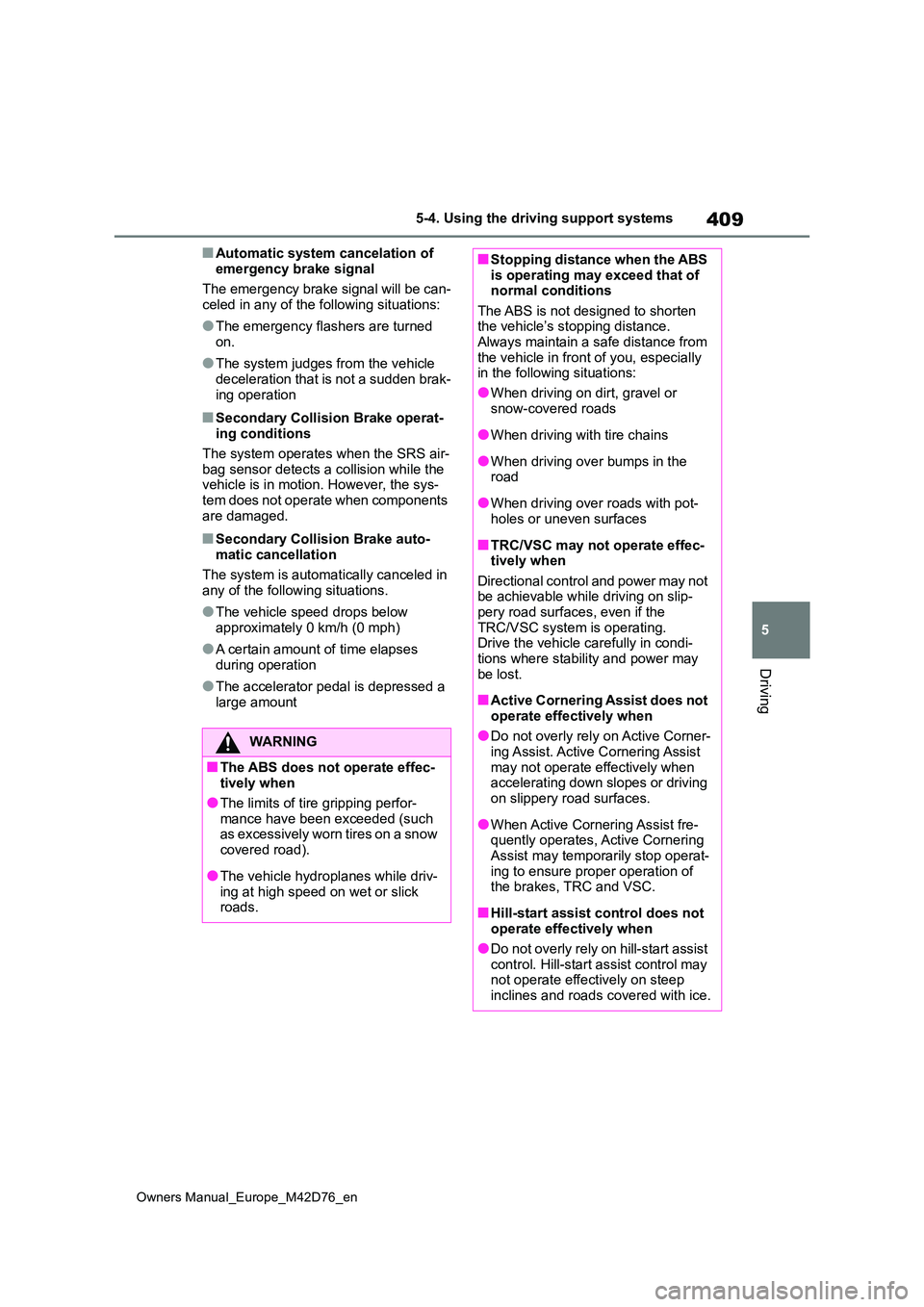
409
5
Owners Manual_Europe_M42D76_en
5-4. Using the driving support systems
Driving
■Automatic system cancelation of
emergency brake signal
The emergency brake signal will be can- celed in any of the following situations:
●The emergency flashers are turned on.
●The system judges from the vehicle deceleration that is not a sudden brak-
ing operation
■Secondary Collision Brake operat- ing conditions
The system operates when the SRS air-
bag sensor detects a collision while the vehicle is in motion. However, the sys-tem does not operate when components
are damaged.
■Secondary Collision Brake auto- matic cancellation
The system is automatically canceled in
any of the following situations.
●The vehicle speed drops below
approximately 0 km/h (0 mph)
●A certain amount of time elapses
during operation
●The accelerator pedal is depressed a
large amount
WARNING
■The ABS does not operate effec- tively when
●The limits of tire gripping perfor-mance have been exceeded (such as excessively worn tires on a snow
covered road).
●The vehicle hydroplanes while driv-
ing at high speed on wet or slick roads.
■Stopping distance when the ABS is operating may exceed that of normal conditions
The ABS is not designed to shorten the vehicle’s stopping distance. Always maintain a safe distance from
the vehicle in front of you, especially in the following situations:
●When driving on dirt, gravel or
snow-covered roads
●When driving with tire chains
●When driving over bumps in the road
●When driving over roads with pot-holes or uneven surfaces
■TRC/VSC may not operate effec-tively when
Directional control and power may not be achievable while driving on slip-pery road surfaces, even if the
TRC/VSC system is operating. Drive the vehicle carefully in condi-tions where stability and power may
be lost.
■Active Cornering Assist does not
operate effectively when
●Do not overly rely on Active Corner- ing Assist. Active Cornering Assist
may not operate effectively when accelerating down slopes or driving on slippery road surfaces.
●When Active Cornering Assist fre-quently operates, Active Cornering
Assist may temporarily stop operat- ing to ensure proper operation of the brakes, TRC and VSC.
■Hill-start assist control does not operate effectively when
●Do not overly rely on hill-start assist control. Hill-start assist control may not operate effectively on steep
inclines and roads covered with ice.
Page 412 of 674
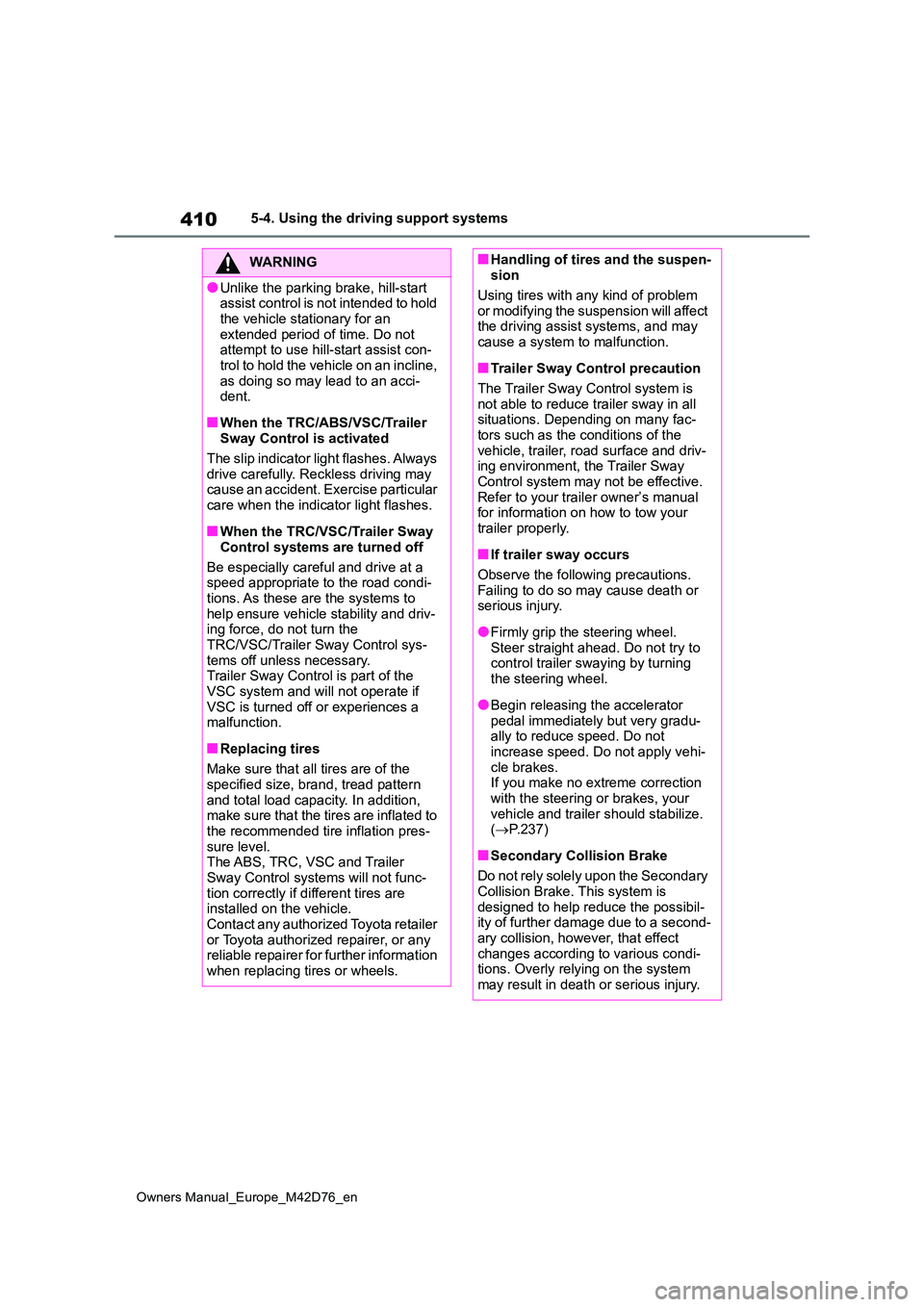
410
Owners Manual_Europe_M42D76_en
5-4. Using the driving support systems
WARNING
●Unlike the parking brake, hill-start assist control is not intended to hold
the vehicle stationary for an extended period of time. Do not attempt to use hill-start assist con-
trol to hold the vehicle on an incline, as doing so may lead to an acci-dent.
■When the TRC/ABS/VSC/Trailer Sway Control is activated
The slip indicator light flashes. Always drive carefully. Reckless driving may cause an accident. Exercise particular
care when the indicator light flashes.
■When the TRC/VSC/Trailer Sway
Control systems are turned off
Be especially careful and drive at a speed appropriate to the road condi-
tions. As these are the systems to help ensure vehicle stability and driv-ing force, do not turn the
TRC/VSC/Trailer Sway Control sys- tems off unless necessary.Trailer Sway Control is part of the
VSC system and will not operate if VSC is turned off or experiences a malfunction.
■Replacing tires
Make sure that all tires are of the
specified size, brand, tread pattern and total load capacity. In addition, make sure that the tires are inflated to
the recommended tire inflation pres- sure level.The ABS, TRC, VSC and Trailer
Sway Control systems will not func- tion correctly if different tires are installed on the vehicle.
Contact any authorized Toyota retailer or Toyota authorized repairer, or any reliable repairer for further information
when replacing tires or wheels.
■Handling of tires and the suspen- sion
Using tires with any kind of problem
or modifying the suspension will affect the driving assist systems, and may cause a system to malfunction.
■Trailer Sway Control precaution
The Trailer Sway Control system is
not able to reduce trailer sway in all situations. Depending on many fac-tors such as the conditions of the
vehicle, trailer, road surface and driv- ing environment, the Trailer Sway Control system may not be effective.
Refer to your trailer owner’s manual for information on how to tow your trailer properly.
■If trailer sway occurs
Observe the following precautions.
Failing to do so may cause death or serious injury.
●Firmly grip the steering wheel. Steer straight ahead. Do not try to control trailer swaying by turning
the steering wheel.
●Begin releasing the accelerator
pedal immediately but very gradu- ally to reduce speed. Do not increase speed. Do not apply vehi-
cle brakes. If you make no extreme correction with the steering or brakes, your
vehicle and trailer should stabilize. ( P.237)
■Secondary Collision Brake
Do not rely solely upon the Secondary Collision Brake. This system is
designed to help reduce the possibil- ity of further damage due to a second-ary collision, however, that effect
changes according to various condi- tions. Overly relying on the system may result in death or serious injury.
Page 413 of 674
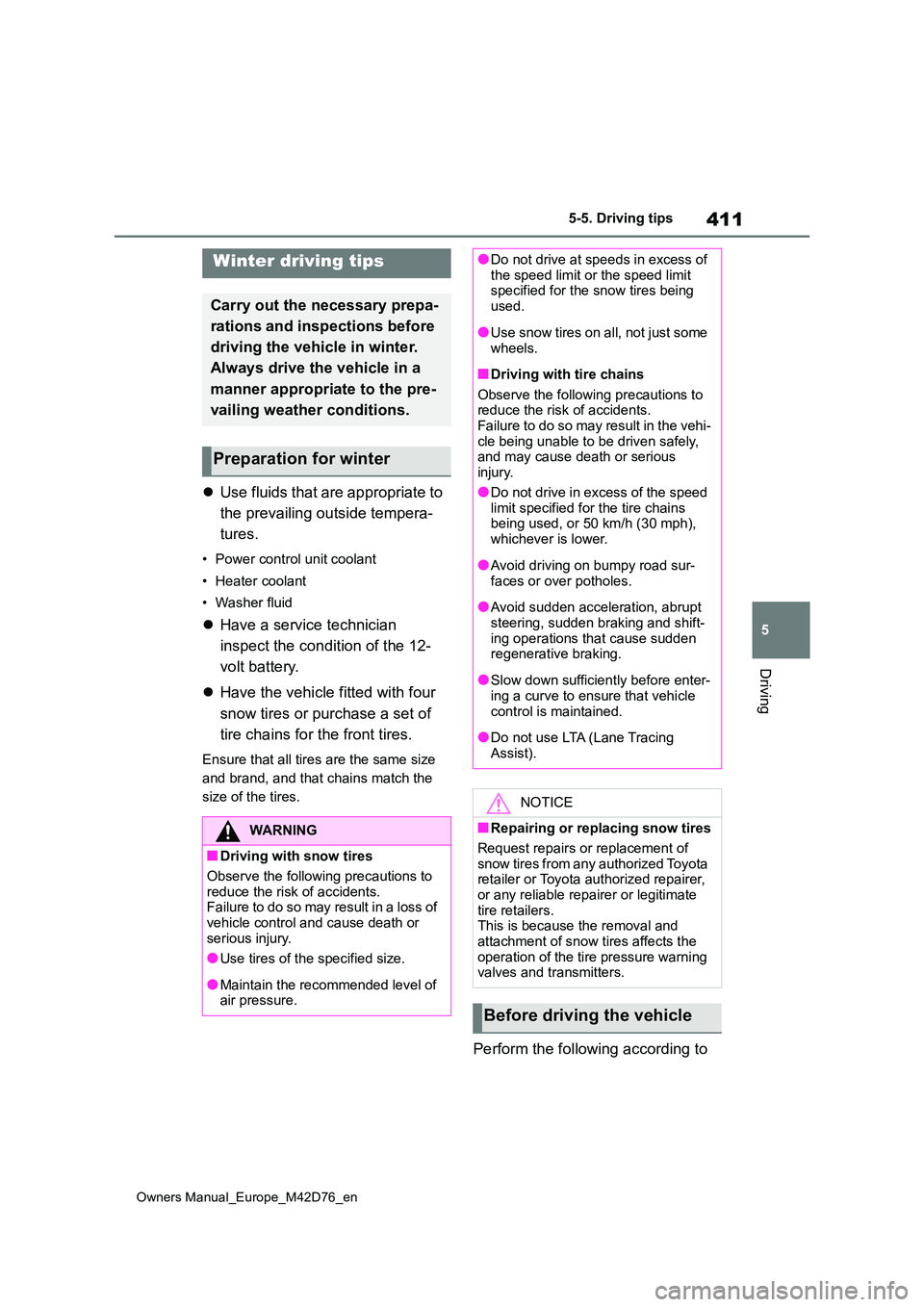
411
5
Owners Manual_Europe_M42D76_en
5-5. Driving tips
Driving
5-5.Driving tips
Use fluids that are appropriate to
the prevailing outside tempera-
tures.
• Power control unit coolant
• Heater coolant
• Washer fluid
Have a service technician
inspect the condition of the 12-
volt battery.
Have the vehicle fitted with four
snow tires or purchase a set of
tire chains for the front tires.
Ensure that all tires are the same size
and brand, and that chains match the
size of the tires.
Perform the following according to
Winter driving tips
Carry out the necessary prepa-
rations and inspections before
driving the vehicle in winter.
Always drive the vehicle in a
manner appropriate to the pre-
vailing weather conditions.
Preparation for winter
WARNING
■Driving with snow tires
Observe the following precautions to
reduce the risk of accidents. Failure to do so may result in a loss of vehicle control and cause death or
serious injury.
●Use tires of the specified size.
●Maintain the recommended level of air pressure.
●Do not drive at speeds in excess of the speed limit or the speed limit specified for the snow tires being
used.
●Use snow tires on all, not just some
wheels.
■Driving with tire chains
Observe the following precautions to reduce the risk of accidents.Failure to do so may result in the vehi-
cle being unable to be driven safely, and may cause death or serious injury.
●Do not drive in excess of the speed limit specified for the tire chains being used, or 50 km/h (30 mph),
whichever is lower.
●Avoid driving on bumpy road sur-
faces or over potholes.
●Avoid sudden acceleration, abrupt
steering, sudden braking and shift- ing operations that cause sudden regenerative braking.
●Slow down sufficiently before enter-ing a curve to ensure that vehicle
control is maintained.
●Do not use LTA (Lane Tracing
Assist).
NOTICE
■Repairing or replacing snow tires
Request repairs or replacement of
snow tires from any authorized Toyota retailer or Toyota authorized repairer, or any reliable repairer or legitimate
tire retailers. This is because the removal and attachment of snow tires affects the
operation of the tire pressure warning valves and transmitters.
Before driving the vehicle
Page 414 of 674
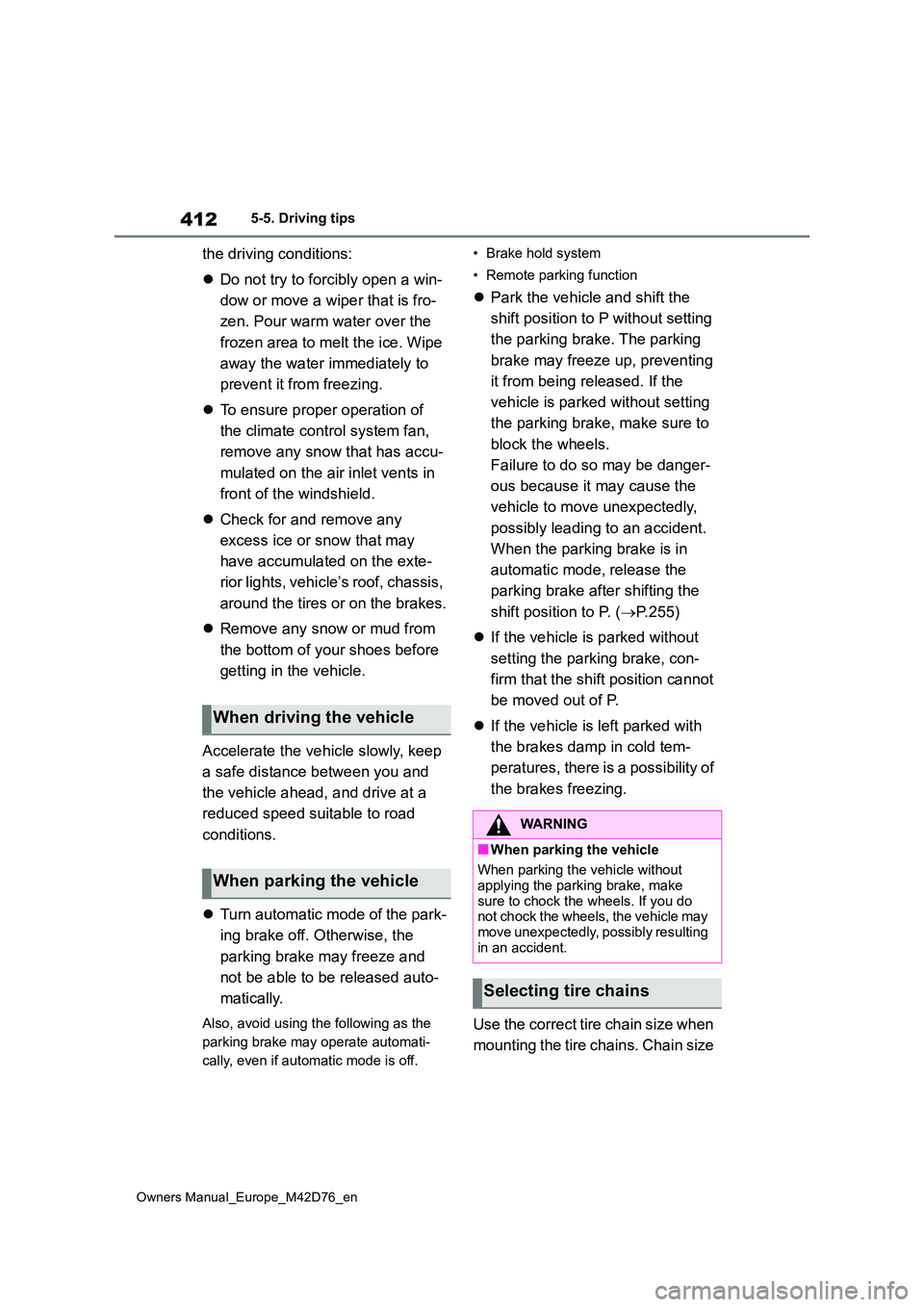
412
Owners Manual_Europe_M42D76_en
5-5. Driving tips
the driving conditions:
Do not try to forcibly open a win-
dow or move a wiper that is fro-
zen. Pour warm water over the
frozen area to melt the ice. Wipe
away the water immediately to
prevent it from freezing.
To ensure proper operation of
the climate control system fan,
remove any snow that has accu-
mulated on the air inlet vents in
front of the windshield.
Check for and remove any
excess ice or snow that may
have accumulated on the exte-
rior lights, vehicle’s roof, chassis,
around the tires or on the brakes.
Remove any snow or mud from
the bottom of your shoes before
getting in the vehicle.
Accelerate the vehicle slowly, keep
a safe distance between you and
the vehicle ahead, and drive at a
reduced speed suitable to road
conditions.
Turn automatic mode of the park-
ing brake off. Otherwise, the
parking brake may freeze and
not be able to be released auto-
matically.
Also, avoid using the following as the
parking brake may operate automati-
cally, even if automatic mode is off.
• Brake hold system
• Remote parking function
Park the vehicle and shift the
shift position to P without setting
the parking brake. The parking
brake may freeze up, preventing
it from being released. If the
vehicle is parked without setting
the parking brake, make sure to
block the wheels.
Failure to do so may be danger-
ous because it may cause the
vehicle to move unexpectedly,
possibly leading to an accident.
When the parking brake is in
automatic mode, release the
parking brake after shifting the
shift position to P. ( P.255)
If the vehicle is parked without
setting the parking brake, con-
firm that the shift position cannot
be moved out of P.
If the vehicle is left parked with
the brakes damp in cold tem-
peratures, there is a possibility of
the brakes freezing.
Use the correct tire chain size when
mounting the tire chains. Chain size
When driving the vehicle
When parking the vehicle
WARNING
■When parking the vehicle
When parking the vehicle without applying the parking brake, make
sure to chock the wheels. If you do not chock the wheels, the vehicle may move unexpectedly, possibly resulting
in an accident.
Selecting tire chains
Page 415 of 674
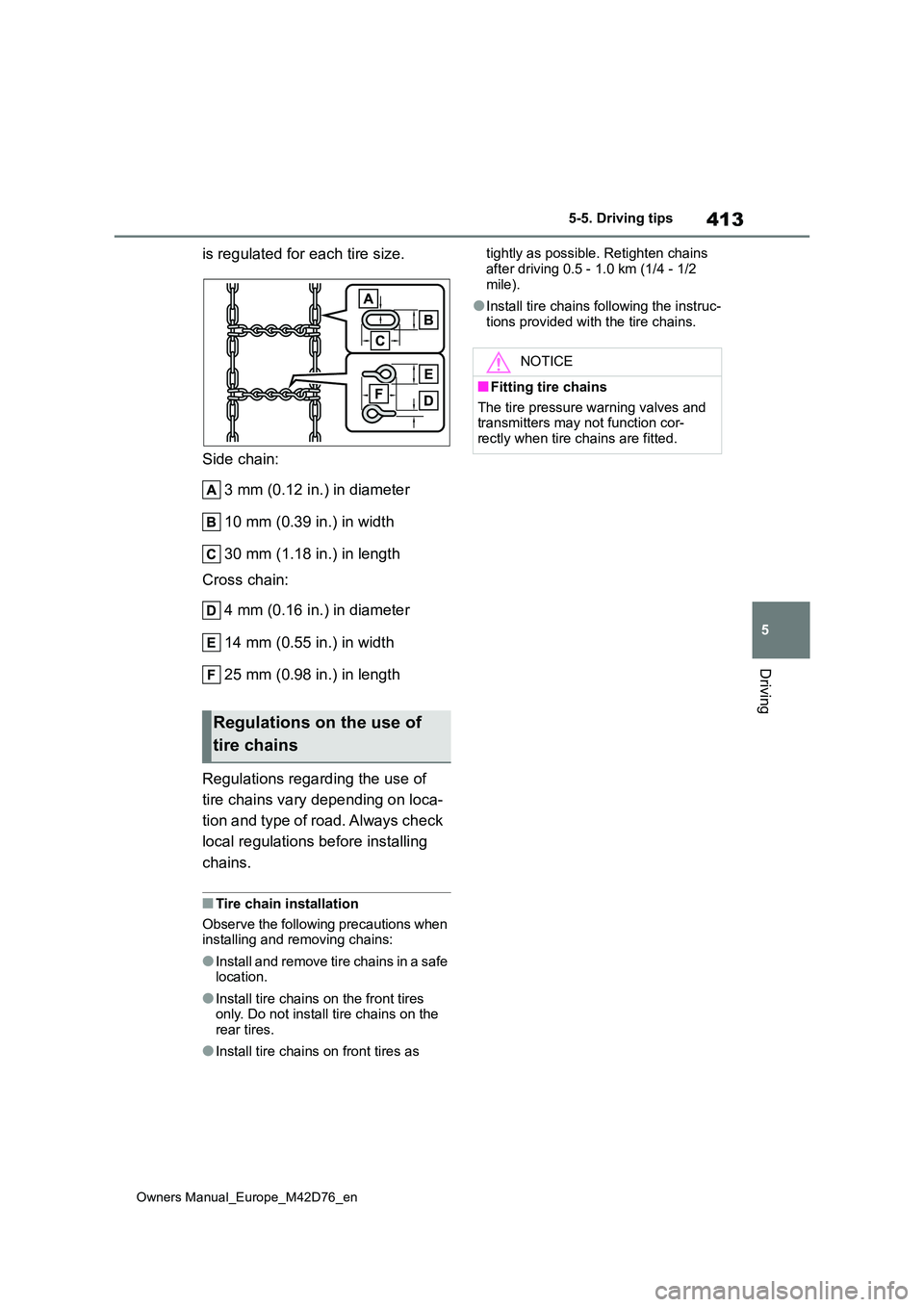
413
5
Owners Manual_Europe_M42D76_en
5-5. Driving tips
Driving
is regulated for each tire size.
Side chain:
3 mm (0.12 in.) in diameter
10 mm (0.39 in.) in width
30 mm (1.18 in.) in length
Cross chain:
4 mm (0.16 in.) in diameter
14 mm (0.55 in.) in width
25 mm (0.98 in.) in length
Regulations regarding the use of
tire chains vary depending on loca-
tion and type of road. Always check
local regulations before installing
chains.
■Tire chain installation
Observe the following precautions when installing and removing chains:
●Install and remove tire chains in a safe location.
●Install tire chains on the front tires only. Do not install tire chains on the rear tires.
●Install tire chains on front tires as
tightly as possible. Retighten chains
after driving 0.5 - 1.0 km (1/4 - 1/2 mile).
●Install tire chains following the instruc-tions provided with the tire chains.
Regulations on the use of
tire chains
NOTICE
■Fitting tire chains
The tire pressure warning valves and transmitters may not function cor-rectly when tire chains are fitted.
Page 416 of 674
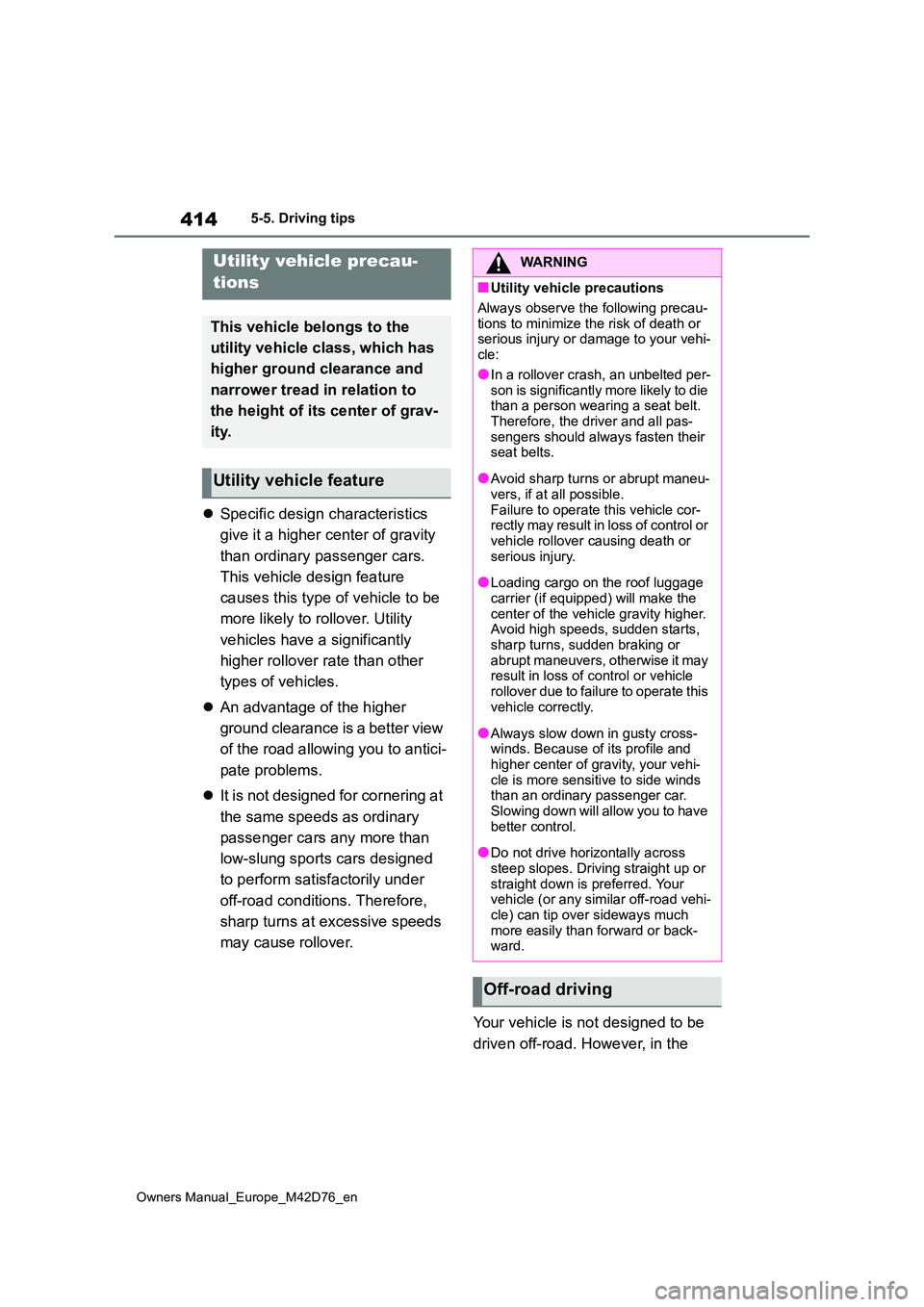
414
Owners Manual_Europe_M42D76_en
5-5. Driving tips
Specific design characteristics
give it a higher center of gravity
than ordinary passenger cars.
This vehicle design feature
causes this type of vehicle to be
more likely to rollover. Utility
vehicles have a significantly
higher rollover rate than other
types of vehicles.
An advantage of the higher
ground clearance is a better view
of the road allowing you to antici-
pate problems.
It is not designed for cornering at
the same speeds as ordinary
passenger cars any more than
low-slung sports cars designed
to perform satisfactorily under
off-road conditions. Therefore,
sharp turns at excessive speeds
may cause rollover.
Your vehicle is not designed to be
driven off-road. However, in the
Utility vehicle precau-
tions
This vehicle belongs to the
utility vehicle class, which has
higher ground clearance and
narrower tread in relation to
the height of its center of grav-
ity.
Utility vehicle feature
WARNING
■Utility vehicle precautions
Always observe the following precau-
tions to minimize the risk of death or serious injury or damage to your vehi-cle:
●In a rollover crash, an unbelted per-son is significantly more likely to die than a person wearing a seat belt.
Therefore, the driver and all pas- sengers should always fasten their seat belts.
●Avoid sharp turns or abrupt maneu-vers, if at all possible.
Failure to operate this vehicle cor- rectly may result in loss of control or vehicle rollover causing death or
serious injury.
●Loading cargo on the roof luggage
carrier (if equipped) will make the center of the vehicle gravity higher. Avoid high speeds, sudden starts,
sharp turns, sudden braking or abrupt maneuvers, otherwise it may result in loss of control or vehicle
rollover due to failure to operate this vehicle correctly.
●Always slow down in gusty cross-winds. Because of its profile and higher center of gravity, your vehi-
cle is more sensitive to side winds than an ordinary passenger car. Slowing down will allow you to have
better control.
●Do not drive horizontally across
steep slopes. Driving straight up or straight down is preferred. Your vehicle (or any similar off-road vehi-
cle) can tip over sideways much more easily than forward or back-ward.
Off-road driving
Page 417 of 674
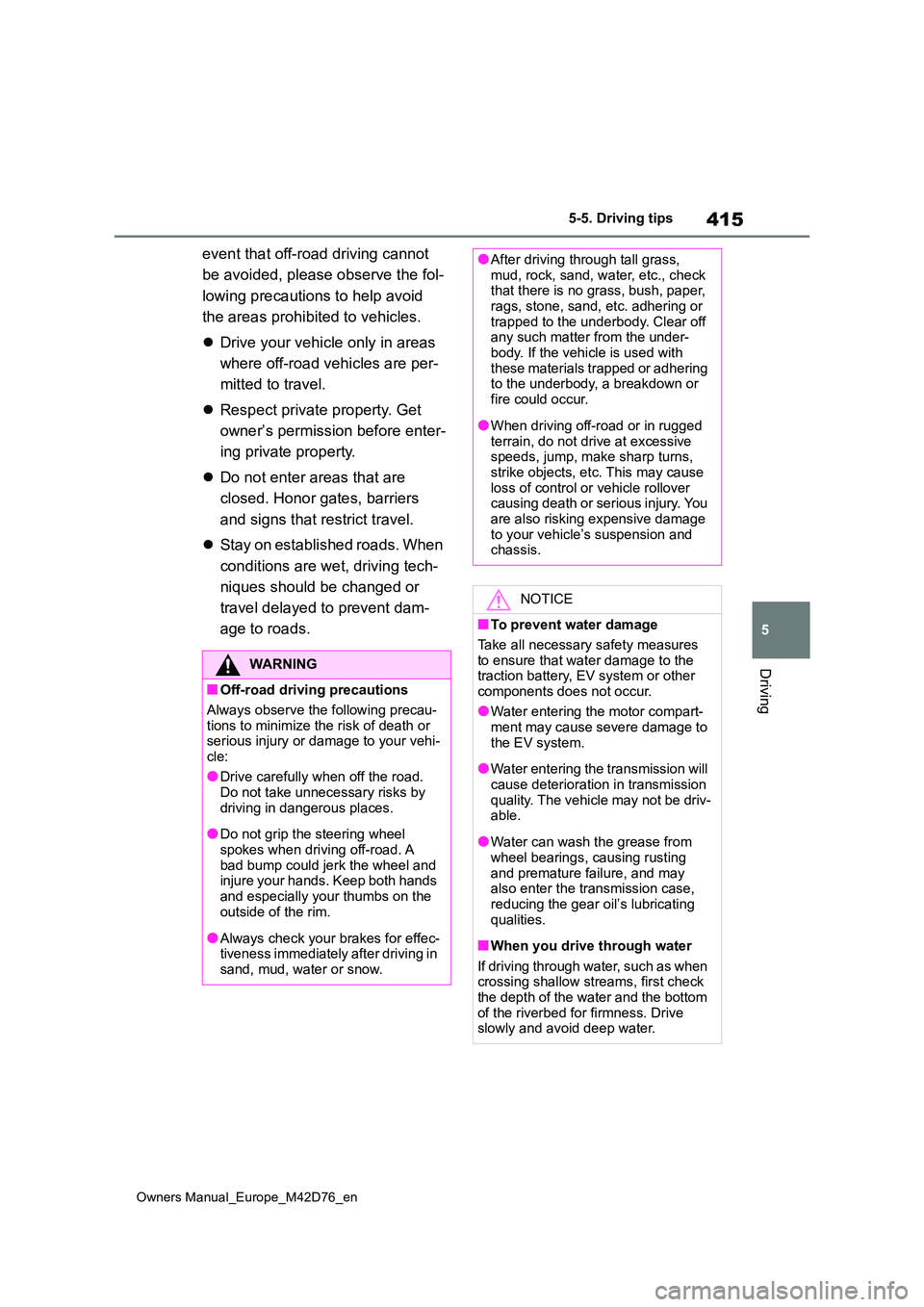
415
5
Owners Manual_Europe_M42D76_en
5-5. Driving tips
Driving
event that off-road driving cannot
be avoided, please observe the fol-
lowing precautions to help avoid
the areas prohibited to vehicles.
Drive your vehicle only in areas
where off-road vehicles are per-
mitted to travel.
Respect private property. Get
owner’s permission before enter-
ing private property.
Do not enter areas that are
closed. Honor gates, barriers
and signs that restrict travel.
Stay on established roads. When
conditions are wet, driving tech-
niques should be changed or
travel delayed to prevent dam-
age to roads.
WARNING
■Off-road driving precautions
Always observe the following precau- tions to minimize the risk of death or serious injury or damage to your vehi-
cle:
●Drive carefully when off the road. Do not take unnecessary risks by
driving in dangerous places.
●Do not grip the steering wheel
spokes when driving off-road. A bad bump could jerk the wheel and injure your hands. Keep both hands
and especially your thumbs on the outside of the rim.
●Always check your brakes for effec-tiveness immediately after driving in sand, mud, water or snow.
●After driving through tall grass, mud, rock, sand, water, etc., check that there is no grass, bush, paper,
rags, stone, sand, etc. adhering or trapped to the underbody. Clear off any such matter from the under-
body. If the vehicle is used with these materials trapped or adhering to the underbody, a breakdown or
fire could occur.
●When driving off-road or in rugged
terrain, do not drive at excessive speeds, jump, make sharp turns, strike objects, etc. This may cause
loss of control or vehicle rollover causing death or serious injury. You are also risking expensive damage
to your vehicle’s suspension and chassis.
NOTICE
■To prevent water damage
Take all necessary safety measures to ensure that water damage to the traction battery, EV system or other
components does not occur.
●Water entering the motor compart- ment may cause severe damage to
the EV system.
●Water entering the transmission will
cause deterioration in transmission quality. The vehicle may not be driv-able.
●Water can wash the grease from wheel bearings, causing rusting
and premature failure, and may also enter the transmission case, reducing the gear oil’s lubricating
qualities.
■When you drive through water
If driving through water, such as when crossing shallow streams, first check the depth of the water and the bottom
of the riverbed for firmness. Drive slowly and avoid deep water.
Page 418 of 674
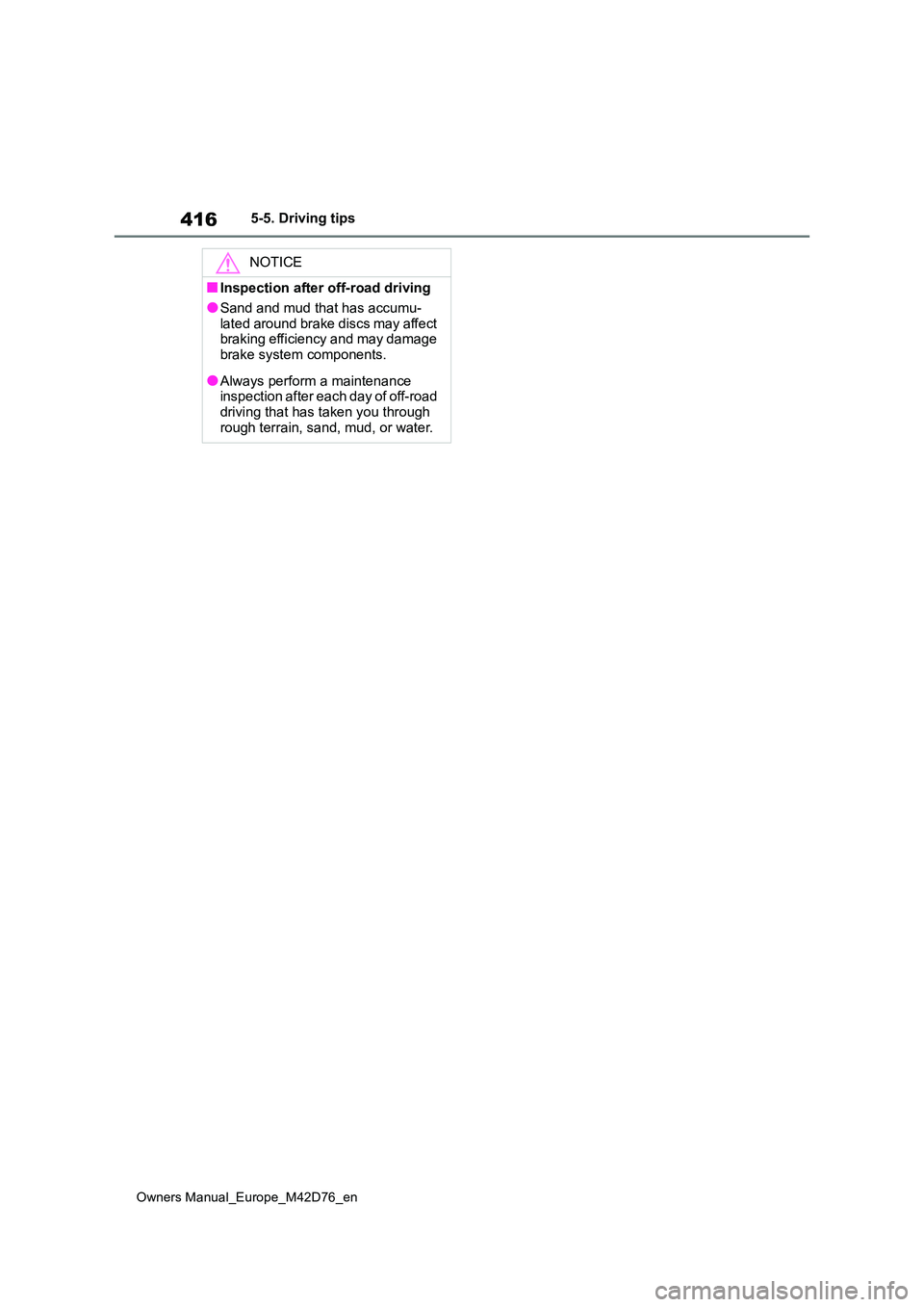
416
Owners Manual_Europe_M42D76_en
5-5. Driving tips
NOTICE
■Inspection after off-road driving
●Sand and mud that has accumu-
lated around brake discs may affect braking efficiency and may damage brake system components.
●Always perform a maintenance inspection after each day of off-road
driving that has taken you through rough terrain, sand, mud, or water.
Page 419 of 674
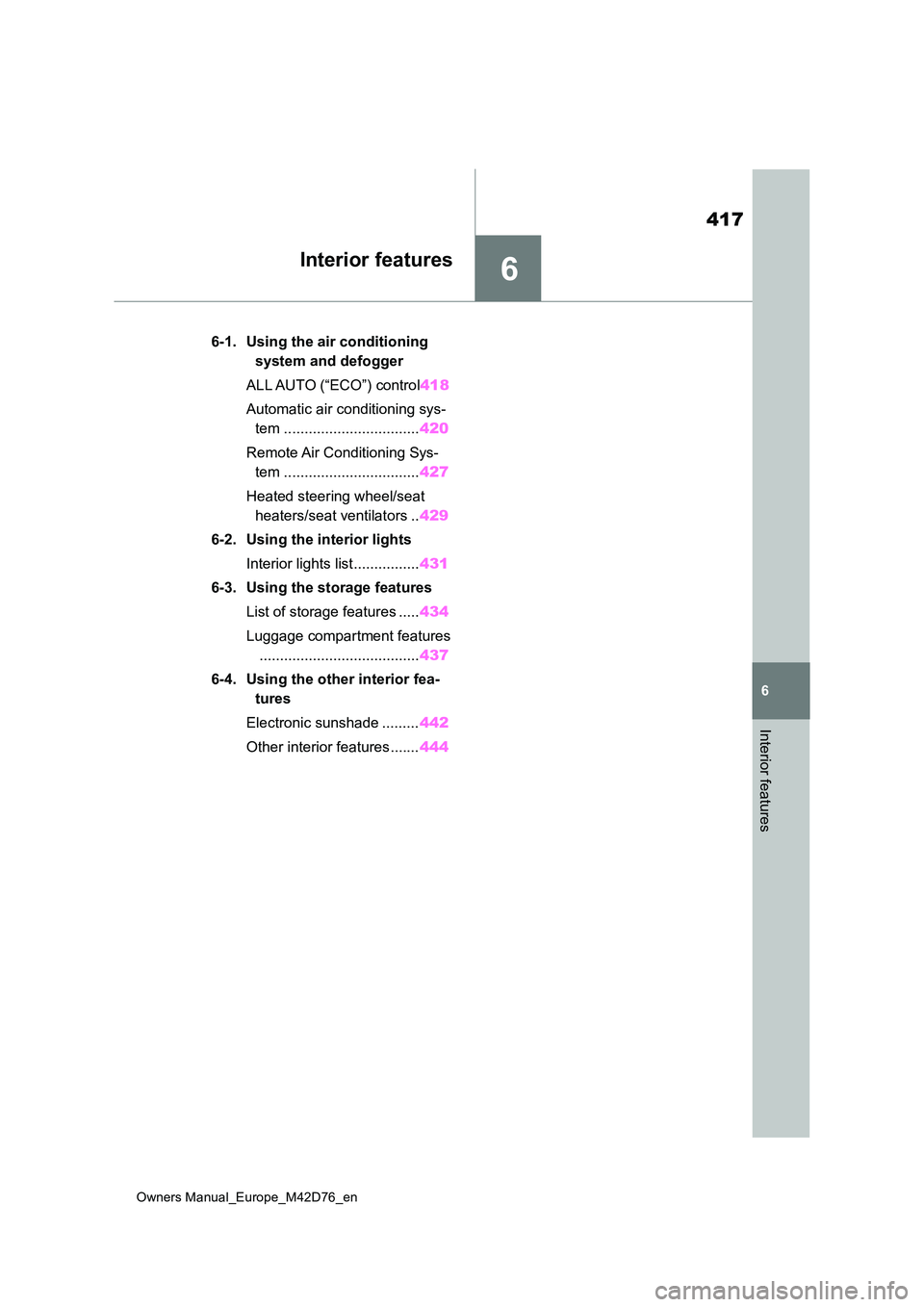
6
417
Owners Manual_Europe_M42D76_en
6
Interior features
Interior features
6-1. Using the air conditioning
system and defogger
ALL AUTO (“ECO”) control 418
Automatic air conditioning sys-
tem ................................. 420
Remote Air Conditioning Sys-
tem ................................. 427
Heated steering wheel/seat
heaters/seat ventilators .. 429
6-2. Using the interior lights
Interior lights list................ 431
6-3. Using the storage features
List of storage features ..... 434
Luggage compartment features
....................................... 437
6-4. Using the other interior fea-
tures
Electronic sunshade ......... 442
Other interior features....... 444
Page 420 of 674
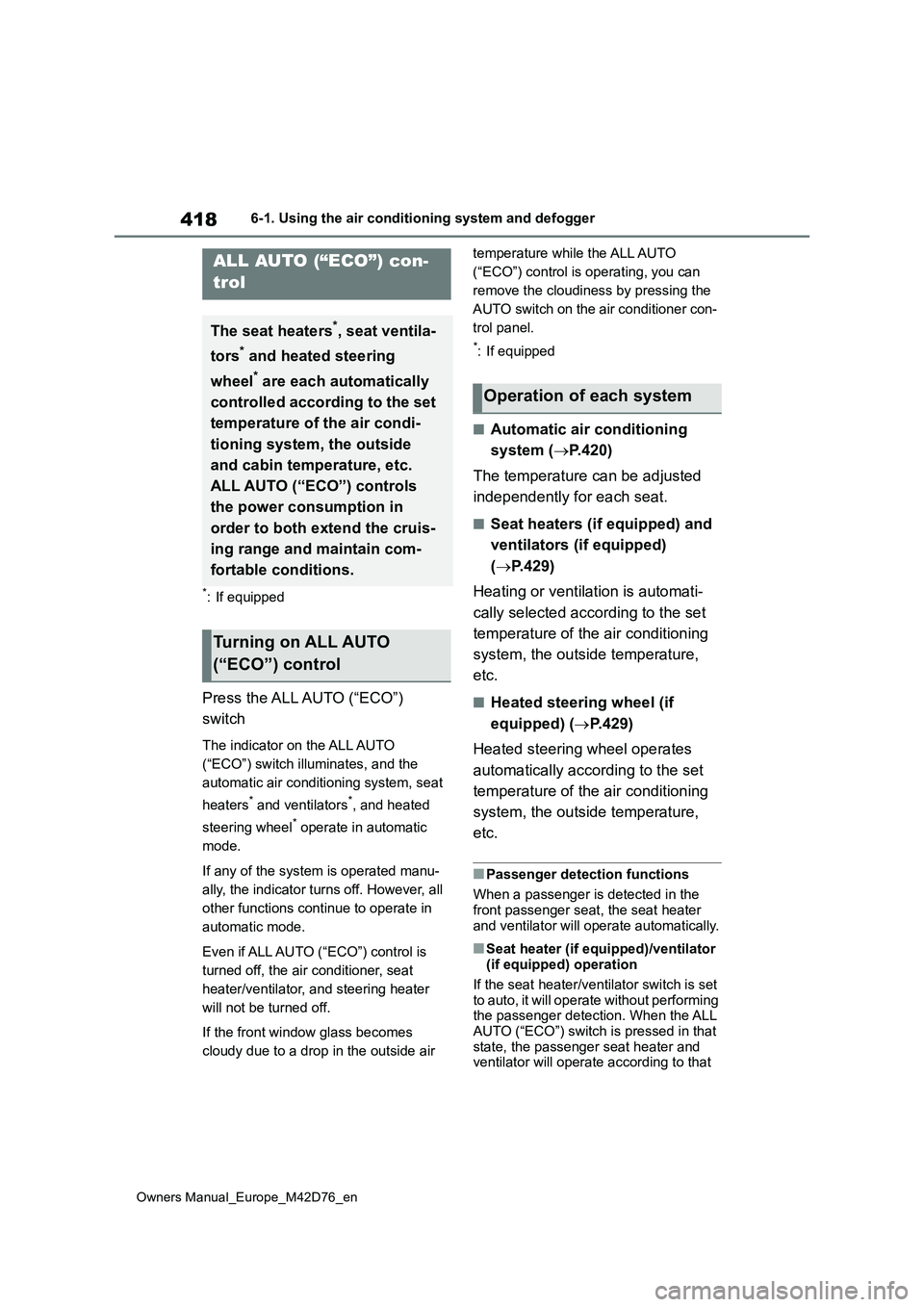
418
Owners Manual_Europe_M42D76_en
6-1. Using the air conditioning system and defogger
6-1.Using the a ir c onditioning sys te m and de fog ger
*: If equipped
Press the ALL AUTO (“ECO”)
switch
The indicator on the ALL AUTO
(“ECO”) switch illuminates, and the
automatic air conditioning system, seat
heaters* and ventilators*, and heated
steering wheel* operate in automatic
mode.
If any of the system is operated manu-
ally, the indicator turns off. However, all
other functions continue to operate in
automatic mode.
Even if ALL AUTO (“ECO”) control is
turned off, the air conditioner, seat
heater/ventilator, and steering heater
will not be turned off.
If the front window glass becomes
cloudy due to a drop in the outside air
temperature while the ALL AUTO
(“ECO”) control is operating, you can
remove the cloudiness by pressing the
AUTO switch on the air conditioner con-
trol panel.
*: If equipped
■Automatic air conditioning
system ( P.420)
The temperature can be adjusted
independently for each seat.
■Seat heaters (if equipped) and
ventilators (if equipped)
( P.429)
Heating or ventilation is automati-
cally selected according to the set
temperature of the air conditioning
system, the outside temperature,
etc.
■Heated steering wheel (if
equipped) ( P.429)
Heated steering wheel operates
automatically according to the set
temperature of the air conditioning
system, the outside temperature,
etc.
■Passenger detection functions
When a passenger is detected in the front passenger seat, the seat heater
and ventilator will operate automatically.
■Seat heater (if equipped)/ventilator (if equipped) operation
If the seat heater/ventilator switch is set
to auto, it will operate without performing the passenger detection. When the ALL AUTO (“ECO”) switch is pressed in that
state, the passenger seat heater and ventilator will operate according to that
ALL AUTO (“ECO”) con-
trol
The seat heaters*, seat ventila-
tors* and heated steering
wheel* are each automatically
controlled according to the set
temperature of the air condi-
tioning system, the outside
and cabin temperature, etc.
ALL AUTO (“ECO”) controls
the power consumption in
order to both extend the cruis-
ing range and maintain com-
fortable conditions.
Turning on ALL AUTO
(“ECO”) control
Operation of each system